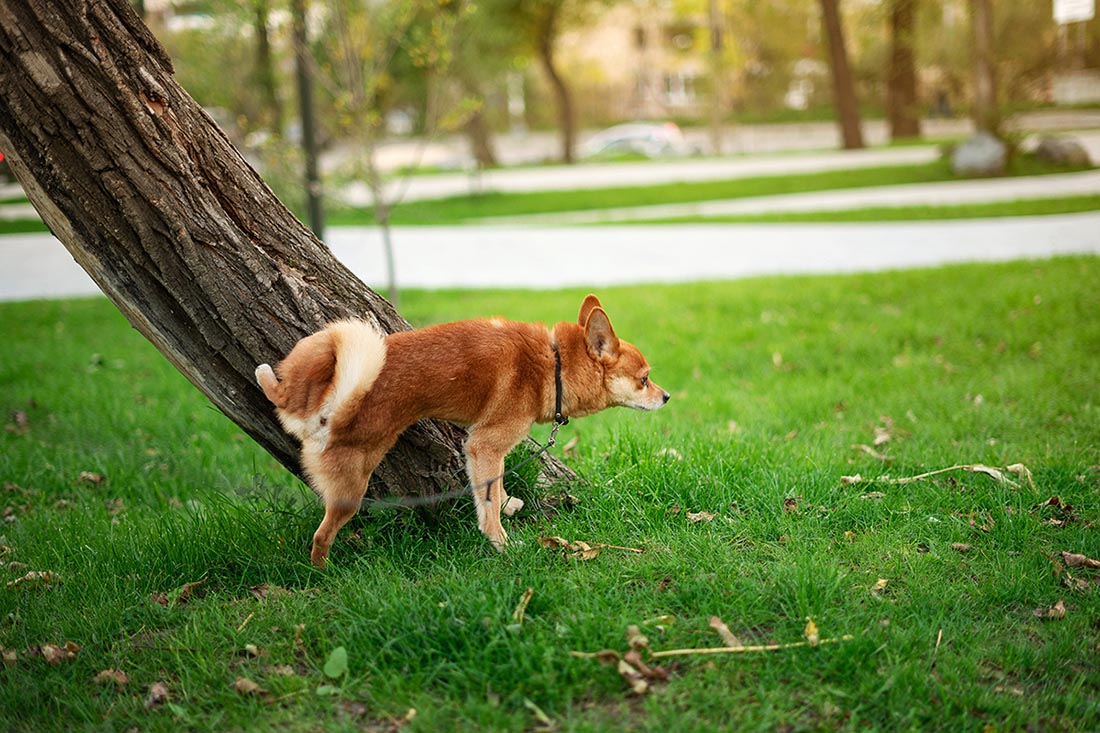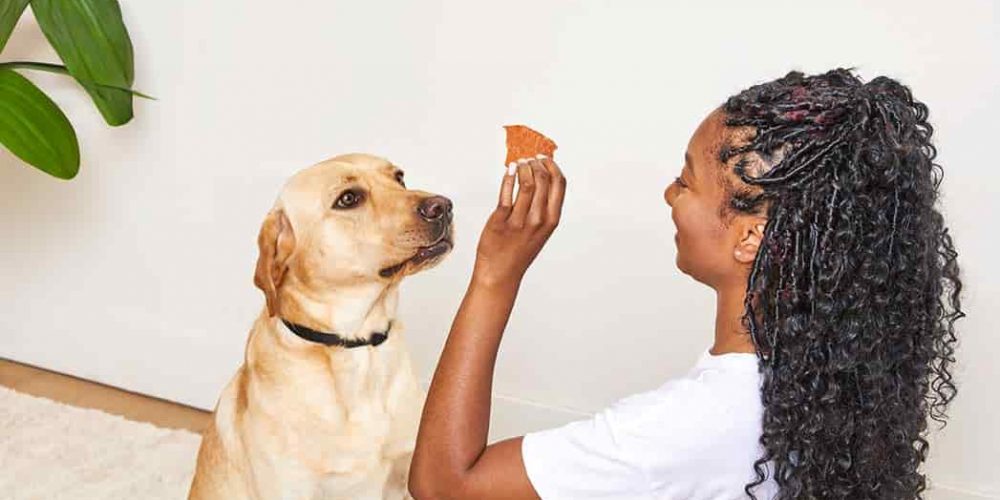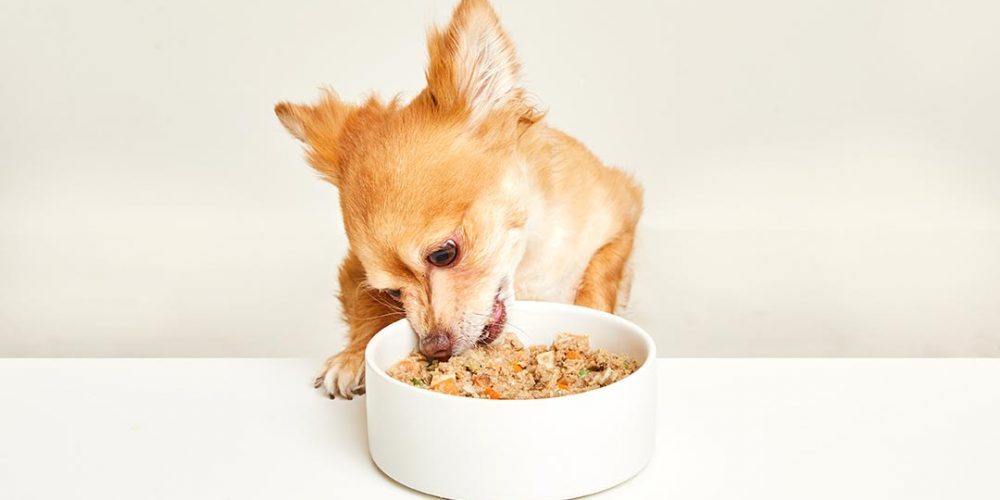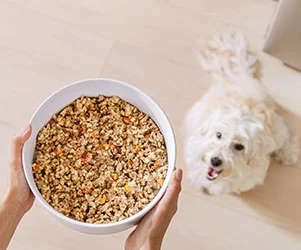TL;DR: Why Your Dog Stops to Sniff and “Pee-Mail” Everywhere
Ever wonder why your dog insists on sniffing everything and leaving little spritzes behind? It’s not just random—it’s communication. Your pup is sending and receiving messages through scent marking, their version of a neighborhood newsfeed.
Key takeaways:
-
Scent marking = dog social networking. Every pee, scratch, or roll leaves behind pheromones that tell other dogs who they are, how they feel, and if they’re up for play.
-
Dogs live in a scent-first world. With up to 300 million scent receptors, their noses gather info we can’t imagine.
-
Not just about peeing. Dogs also mark with their paws, anal glands, feces, and even by rubbing their face or body.
-
Indoor marking? Often linked to stress, anxiety, or medical issues like UTIs—never punishment-worthy.
-
Training + enrichment help. More sniff walks, consistent routines, and positive reinforcement can curb unwanted marking.
Keep reading to decode your dog’s scent-marking language, learn what’s normal, and discover how to manage marking with patience and science-backed tips.
You know how your pooch stops every few feet to sprinkle a few drops? They sniff, circle, and pee every bush or mailbox like they’re checking their texts. And it turns out, they are! Those tiny spritzes are your dog’s version of pee mail.
Scent marking is one way dogs communicate with each other. Each mark tells the story of who’s been there, how they’re feeling, and whether they’re up for saying hello.
To us, it’s just another pit stop. But to your dog, every sprinkle is a message board bursting with juicy updates.
Let’s decode what your dog’s nose knows that you don’t and what you can do if scent marking becomes a problem.
The Science Behind Your Dog’s Smelling Capabilities
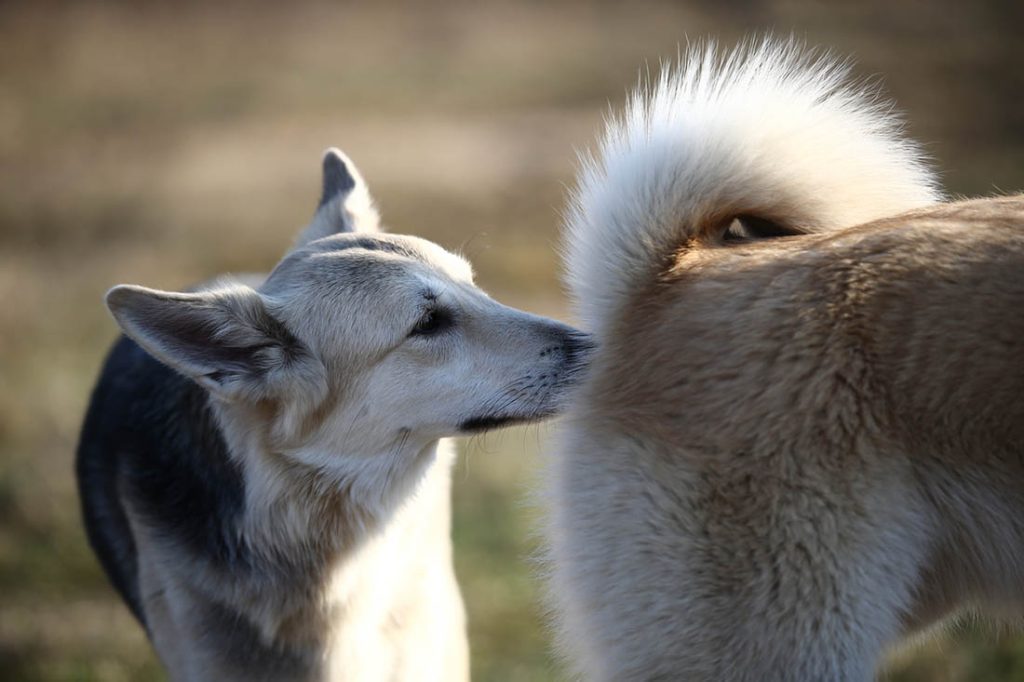
Your dog wants to make frequent stops because he lives in a scent-first world.
While humans rely primarily on their eyes, your dog sniffs his. Dogs have up to 300 million scent receptors in their noses. For comparison, humans only have around six million. Plus, dogs have a larger part of their brain devoted to processing scent.
According to veterinarians at VCA Animal Hospitals, scent marking is a natural behavior in dogs. It’s the dog social network. Every dog has a unique mix of pheromones, acting as a personalized ID. These pheromones are natural chemicals that indicate whether the dog is male or female, their age, and even their level of health and confidence.
Here’s an interesting twist: scent marking isn’t only about your dog’s urine. Your pooch has scent glands tucked into multiple spots, giving them multiple “channels” for leaving their scent behind.
Ways Dogs Scent Mark
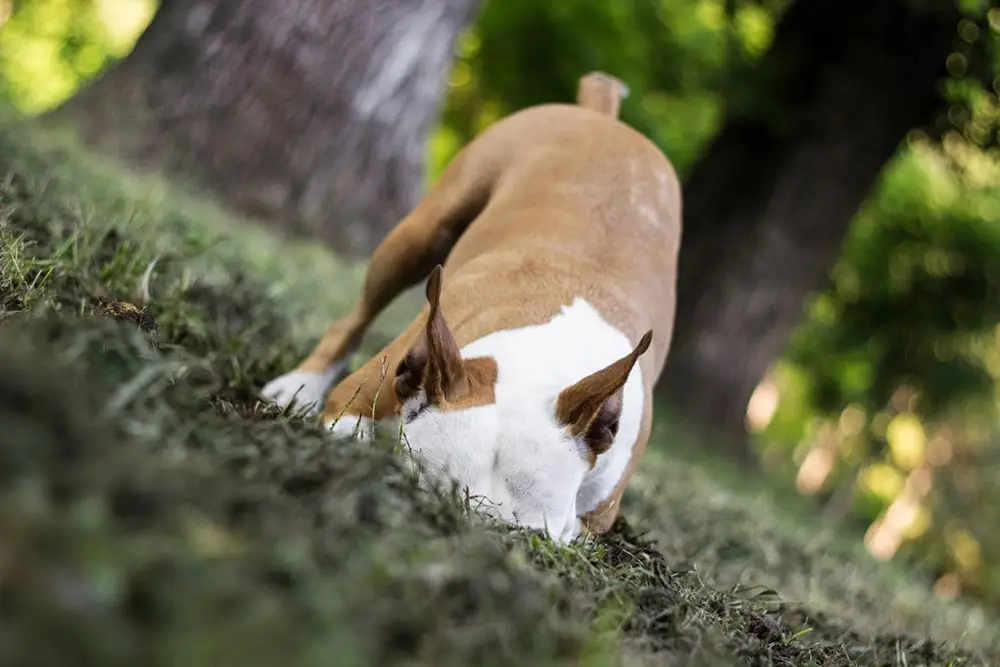
It’s easy to think scent marking is just dribbling small amounts of urine on things. Yet, dogs have multiple ways to share their signature scent, including via:
- Urine
- Paw pads
- Anal glands
- Fecal marking
- Body rubbing and rolling
- Facial and ear glands
Let’s break down each type of dog scent marking.
1. Urine Marking
Yes, urine marking is a classic behavior. When your dog dribbles a few drops here and there, they’re saying, “I was here.” Urine carries those pheromones that can last for days, allowing other dogs to detect them.
Intact males are especially prone to urine marking once they reach sexual maturity, usually around six months to a year old. Their hormones drive a strong urge to claim territory and advertise their status to other dogs.
Neutering can reduce this hormone-driven marking by up to 40%, according to veterinary behaviorists. However, if marking has become a learned habit, you’ll need some patient training to help your pup unlearn it.
2. Paw pads
When your dog insists on scratching and kicking the ground after bathroom duty? They’re leaving behind their personal scent embedded in the sweat glands between their paw pads. Scratching the ground releases their scent into the ground and leaves those scratch marks, reinforcing their “I was here” message.
3. Anal Glands
Dogs have two anal sacs beside their rectum that release a musky, signature scent when they poop or when they startle. That’s why dogs sniff each other’s butts. They’re “reading” one another. When your dog sniffs the ground where other dogs have poo’d, they’re learning who was there before them.
4. Fecal Marking
You guessed it, pooping acts as a message board. Feces carry pheromones from both the digestive tract and the anal glands. If your dog wants to poop near where other dogs have pooped, it’s a dominance move. “I was here last.”
5. Body Rubbing and Rolling
When your dog joyfully rolls in the grass or something gross, this is another form of scent marking. Dogs roll to either deposit their own scent or absorb new scents, depending on the context. It’s instinctual.
6. Facial and Ear Glands
Your dog’s face holds tiny sebaceous glands that release subtle oils. When your pooch rubs their head or ears against furniture, doorways, or you, they’re leaving their signature scent.
It’s part affection and part telling the world, “This is mine.”
Why Do Dogs Mark Their Territory? There’s More to It than Turf.
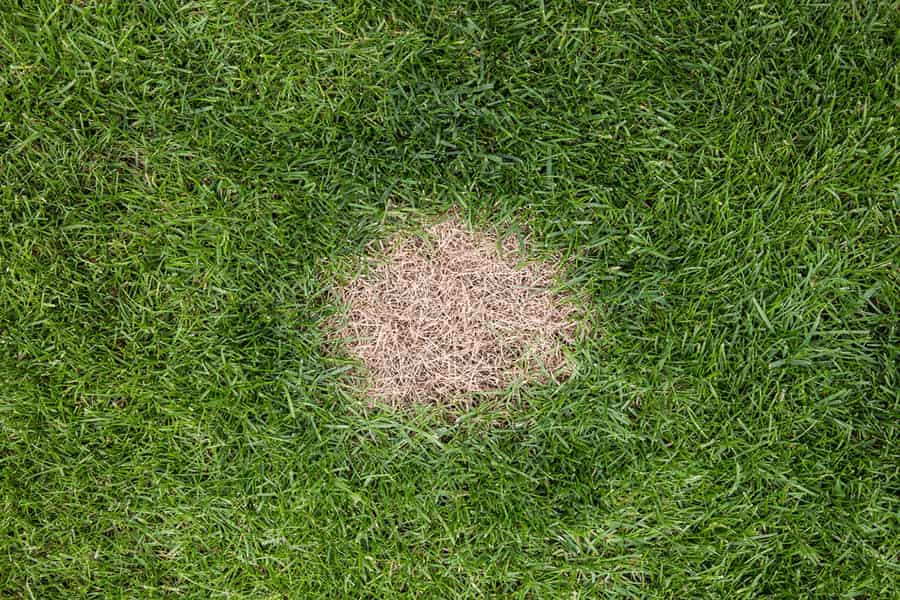
Now that you know the multiple ways dogs scent mark, let’s explore why they do this, because scent marking goes beyond staking a claim.
Dogs mark for all kinds of reasons, like:
- to claim turf
- making friends
- calming their nerves
- flirting
- re-marking other dog’s scents
And it can all happen on the same walk. Here’s a deeper look at why dogs mark things.
Territory marking
Dogs do mark to establish boundaries, especially when they sense other animals nearby. Your dog might like to mark his yard. This is a statement to other dogs that the territory is claimed.
Social networking
You have social media; your dog has scent marking. Their scent updates share their mood and if they’re open to making new friends.
Anxiety or Insecurity
When routines change, dogs might leave their scent more frequently. It’s a way to reclaim familiarity. Marking can be a form of self-soothing when the world feels chaotic. Some behaviorists suggest that enrichment, stability, and predictable routines help reduce stress-driven marking behavior.
Mating messages
If your pet is not spayed or neutered and is in heat, they’ll use scent marking to broadcast their availability. It’s like Tinder for dogs, minus the swiping.
Re-marking over other dogs’ scents
Dogs often remark over one another’s scent to assert themselves or “reply” to the message. It’s a form of dominance and curiosity.
What’s Normal Scent Marking and What’s Not?
It’s totally normal for dogs to sniff and mark outdoors on walks. But if your pup’s behavior changes and starts marking inside, that’s a concern.
Normal marking looks like:
- Spritzes on walks
- Re-marking the territory outside
- Ground scratching
When to be concerned about dog marking:
- Pain or straining while urinating
- Indoor accidents
- Increase in frequency
If your pooch suddenly forgets his housetraining or seems uncomfortable, it could be due to a medical reason. Common medical issues include:
- Urinary tract infections
- Bladder stones
- Kidney problems
- Hormonal changes
If your dog’s marking habits change, it’s time to schedule a veterinarian appointment because it can be a signal that your dog is feeling discomfort.
Why Did My Dog Pee on the Couch?
If your dog starts indoor marking and you’ve ruled out a medical problem, it could signal your dog is stressed, anxious, or responding to new smells.
Common triggers include:
- New guests, pets, or furniture
- Residual odors from past accidents
- Changes in schedule or environment
- Separation anxiety
In such cases, you don’t want to punish your dog because that can make it worse. Instead:
- Use enzymatic cleaners to break down odor molecules
- Use baby gates to limit your dog’s access to problem areas.
- Use belly bands or dog diapers to prevent repeat offenses while you retrain
- Increase outdoor potty breaks and lavish praise on your pup for successful tinkles.
- Maintain consistent routines.
Positive reinforcement and predictability help rebuild confidence. Dogs love routine. When you disrupt it, it can cause anxiety and fuel marking. If anxiety is driving your dog’s marking behavior, pheromone diffusers like Adaptil may soothe your dog during stressful transitions such as moving or adding a new pet to your home.
How to Manage Inappropriate Scent Marking
If your dog is a chronic marker, training and management can make a big difference.
Try these approaches to deter excessive marking:
- Reward outdoor peeing every time with happy praise and high-value treats. Consistency works wonders.
- Interrupt indoor marking calmly and take them outside.
- Offer sniff walks and puzzle toys to satisfy their need for scent-based stimulation.
- Neuter or spay your dog if you haven’t already. It’s a good idea to neuter or spay your pup when they’re young, before the marking habit becomes ingrained.
- Avoid harsh punishment because it can cause your dog more stress.
In your dog’s experience, marking is a form of communication. Now that you know this, you can help them find a better way to communicate.
Sniffing Is Enrichment, Not Just a Potty Break
Sniffing is a natural dog behavior and one way dogs decompress. Daily sniff walks can lower your dog’s stress and boost their mood. Think of it as their version of scrolling through their social feed.
Scent marking is dog language. It’s a way for them to connect with other dogs in the neighborhood and express themselves.
So the next time your dog stops for the fifty-first sniff of the walk, remember, they’re catching up on the neighborhood news. It’s beneficial for their nose, brain, and mental wellness.
This content is for informational use only and does not replace professional nutrition and/or medical advice, diagnosis, or treatment. It is not a substitute for and should not be relied upon for specific nutrition and/or medical recommendations. Please talk with your veterinarian about any questions or concerns.
Sources
Hunt, Rebecca L., Helen Whiteside, and Susanne Prankel. 2022. “Effects of Environmental Enrichment on Dog Behaviour: Pilot Study.” Animals 12 (2): 141. https://doi.org/10.3390/ani12020141.
“Urine Marking in Dogs.” 2004. Advances in Small Animal Medicine and Surgery 17 (5): 3–4. https://doi.org/10.1016/j.asams.2004.09.002.
Buzhardt, Lynn, and Ryan Llera. 2009. “How Dogs Use Smell to Perceive the World.” Vca_corporate. 2009. https://vcahospitals.com/know-your-pet/how-dogs-use-smell-to-perceive-the-world.
Buzek, Anna, Katarzyna Serwańska-Leja, Anita Zaworska-Zakrzewska, and Małgorzata Kasprowicz-Potocka. 2022. “The Shape of the Nasal Cavity and Adaptations to Sniffing in the Dog (Canis Familiaris) Compared to Other Domesticated Mammals: A Review Article.” Animals : An Open Access Journal from MDPI 12 (4): 517. https://doi.org/10.3390/ani12040517.

